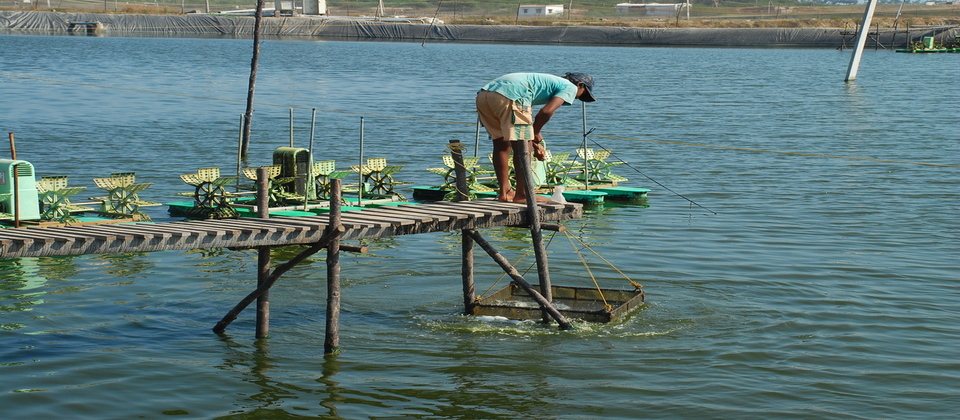Dr. Karthik Ramachandran
The production process in shrimp aquaculture is determined by biological, technological, economical and environmental factors.
In general, shrimp ponds are enclosed cultivation systems, subject to periodic water renewal to compensate for volume changes (due to evaporation) and salinity changes (evaporation, precipitation) and to maintain water quality. The microbial diseases are commonly implicated in episodes of mortality, so that our Indian farmers prefer to use commercial antibiotics available in markets. However, the use of antibiotics has recently become a major public concern because their use can lead to the development of drug resistant bacteria, thereby reducing drug efficacy. “Though shrimp culture has undergone rapid development in India, successful production is increasingly hampered especially by diseases in addition to environmental pollution and poor management practices.” The accumulation of antibiotics both in the environment and in shrimp tissues can be potentiallyrisky to consumers and the environment. One of the most important problems faced by our Indian shrimp culture farmer is excess Ammonia in pond water and sediment which is caused by excess feed, fecal matter and dead algae deposited in the bottom of the pond. Due to this, shrimps are exposed to toxic gases like NH3, NO2 and H2S further leads to eutrophication in the culture system and cause stress to the animal and ultimately end with microbial diseases and high mortality occurs.
Though shrimp culture has undergone rapid development in India, successful production is increasingly hampered especially by diseases in addition to environmental pollution and poor management practices. Of all the infectious diseases, bacterial infections cause serious diseases like vibriosis, White spot, ulcer, tail rot, necrosis etc.
Currently, antibiotics have been widely used in shrimp aquaculture to control bacterialinfections. However, the use of antibiotics has recently become a major public concern because their use can lead to the development of drug resistant bacteria, thereby reducing drug efficacy. Moreover, the accumulation of antibiotics both in the environment and in shrimp tissues can be potentially risky to consumers and the environment. Such adverse effects have prompted scientists to search for alternatives to replace antibiotics in controlling diseases in shrimp farms. One of the potential alternatives is bacterial based approach especially probiotics.
Pobiotic as “a live microbial feed supplement which beneficially affects the host animal by improving its intestinal balance”. Although macro organisms of the ocean have proved to be good sources of novel bioactive metabolites, largescale productions of these bioactive metabolites have been difficult. Bacillus specieswere recently employed in an attempt to improve the aquatic environment in shrimp aquaculture. The use of these beneficial bacteria, to control pathogens through a variety of mechanisms, is mainly considered as an alternative to antibiotic treatment. The use of probiotics in human and animal nutrition is well documented and recently, they are being applied in aquaculture. Several studies on probiotics have been published during the last decade.
“Nitrification is a natural process, which occurs in pond ecosystem but during several occasions, this may not be reaching a higher order of magnitude.” The direct impacts include release of eutrophicating substances and toxic chemicals, the transfer of diseases and parasites to wild stock, and the introduction of exotic and genetic material into the environment. The environmental impact can also be indirect through the loss of habitat and niche space, and changes in food webs. Nitrite is also toxic to crustaceans, although the mechanism is poorly understood. The long exposure of P.monodonjuveniles to concentrations of 4 mg/L NOz- N or greater in water with high salinities significantly reduces shrimp growth and the lethal effects of nitrite on several penaeid species have been studied and information is lacking with respect to its effects on L.vannamei particularly when grown in salinities lower than 15 g/L. There are three processes of remediation viz., physical, chemical and biological. These processes have been used to invalidate or eliminate the pollutant/toxicants from the aquatic environment. The physical process has limits to application but larger amount of water can be processed through it. Nitrification is a natural process, which occurs in pond ecosystem but during several occasions, this may not be reaching a higher order of magnitude. Application of nitrifying bacterial consortium to growth artificially and reduce toxicity of ammonia in aquatic system is used in this experiment as a tool for bioremediation Nitrifying bacteria not only convert ammonia to nitrate but also reduce carbon dioxide to organic matter (carbohydrate), obviously these chemoautotrophic bacteria use energy released by theoxidation of ammonia to nitrate and reduce carbon dioxide to organic carbon. However, the amount of organic matter synthesized by chemoautotrophic bacteria is very small in comparison to the quantum produced by photosynthesis. Studies should be focused on, to develop and evaluate the probiotic and beneficial effect of different beneficial microbes (microbial consortium) on P.monodon and L.vannamei culture to enhance the production on a sustainable manner.
Hence, extrapolation of microbial consortium as feed and/or water probiotics in shrimp culture will definitely prevent the aquaculture ponds from undergoing organic matter accumulation, ammonification, eutrophication and prevent the environment from pollution and also control the microbial diseases to the shrimps and enhance the productivity of the farms to the benefit of local economies in an eco-friendly ambience without antibiotics.
(Dr. Karthik Ramachandran has a doctorate in Aquaculture Probiotics and currently works as Senior Technical Consultant & Director with Vetbiotics Animal Healthcare Pvt Ltd, Mumbai)

